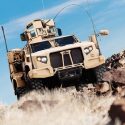History professor documents GI conduct in WWII France
On June 6, 1944, a massive military force arrived on the beaches of Normandy in a surprise invasion intended to overthrow Nazi Germany. The story of brave Allied forces splashing ashore under heavy fire has been immortalized in novels, memoirs, documentary films, and blockbuster movies — with American GIs cast as the unequivocal heroes of the day.

Mary Louise Roberts
A famous photo circulating the globe at the time summed things up: a happy GI embraced by ecstatic French girls.
But that photo also illuminates a darker side of the story, according to University of Wisconsin–Madison History Professor Mary Louise Roberts. In her new book, “What Soldiers Do: Sex and the American GI in World War II France,” Roberts writes that while heroism abounded during liberation, for some Allied troops, command of geographical territory meant command of sexual territory, as well. As they entered and occupied the port towns of Le Havre, Reims, Cherbourg and Marseilles, many soldiers took what they wanted — when and where they wanted — from the French female population.
Back home, the story was spun of grateful (and promiscuous) French damsels rescued in their distress. But French archives, Roberts discovered, held vastly different accounts.
Roberts remembers the moment she opened the thick dossier, sealed for some 70 years, in the little archive in Le Havre, the French port city at the heart of Allied troop movement.
“I discovered I was sitting on a bomb,” says Roberts. “Here were letters, between the mayor of Le Havre and Colonel Weed [the American commander in the region], pleading for better regulation of troops’ behavior — as well as police reports and citizen complaints about everything they were witnessing.”
“Everything” included public sex, harassment, prostitution, and rape. The information posed a direct threat to the “myth of the manly GI,” says Roberts. Determined to air the French perspective, which she says has long been missing from widely read accounts of the Allied liberation of France, she began to tug on the end of this thread.
“I started digging in more archives,” she says. “I went to the police archives in Paris. I spent much time in the National Archives in Washington, D.C., looking through hundreds of boxes from SHAEF [Supreme Headquarters Allied Expeditionary Force]. Men did fight heroically. What we accomplished was amazing. But I don’t think we should purify it. That’s when we run into trouble.”
“I discovered I was sitting on a bomb. Here were letters … pleading for better regulation of troops’ behavior — as well as police reports and citizen complaints about everything they were witnessing.”
Mary Louise Roberts
Deconstructing what scholars call a sacred national myth can bring down an onslaught of criticism. But John Hall, a UW–Madison professor of military history, says that when we only focus on what went right, we miss the opportunity to lay out problems in detail and examine them.
“It’s why historians accentuate the negative,” he says. “There is far more to be learned from our mistakes, than from those episodes we think redound to our credit.”
Hall, who taught at the U.S. Military Academy before coming to UW–Madison, says young cadets arrive at West Point believing that unflattering renditions of American history are un-American. But he says West Point instructors teach them that dwelling on errors is vital to military history.
Like all historians, Roberts and Hall are trained to look critically at established narratives and engage colleagues and students in questioning and analysis.
“The task of academic historians is to separate national mythology from what actually happened,” says Hall. “As a student of history, if you want a more complete picture, you’ll have to read broadly.”
But what exactly is national mythology?
World War II holds a place in our collective consciousness as “the Good War.” According to Mary Layoun, a UW–Madison professor of comparative literature who has studied the nationalistic narratives that arise in crisis and has written about occupations and invasions, from World War II onward, the myth in this context does not mean something untrue. Rather, it is a story that becomes larger than life — and brooks no challenge.
“Men did fight heroically. What we accomplished was amazing. But I don’t think we should purify it. ”
Mary Louise Roberts
“It’s a way of explaining forces in the world around us,” she says. “But when we mythologize battle or war, we adopt a preferred self-image that presents itself as unequivocal or indisputable.”
And therein lies the danger.
“If we only have unequivocal heroes, then we shortchange heroism itself,” says Layoun. “There are plenty of reasons to step back and say, ‘From whose point of view is that the case? What are the other pieces of this story? What is this image serving?'”
Like Roberts, Layoun has dug deep into the ways in which women are exploited in wartime. Peering under established narratives about battle and valor, she has discovered untold stories, such as the rise of women’s organizations in Bosnia and Cyprus that teach and talk about the gender-specific impacts of conflicts there. Looking through an alternative lens allows room for a richer narrative, she says.
“Theirs are stories of courage and heroism, too,” she points out.
In “What Soldiers Do,” Roberts says she wanted to present an alternative history that explores war in a social context. With its focus on a previously ignored subject — the sexual habits of American soldiers — the book may provide useful insights into the sexual assault scandal unfolding in the U.S. military today, she says.
—Mary Ellen Gabriel
Tags: books, history, international, military, research

